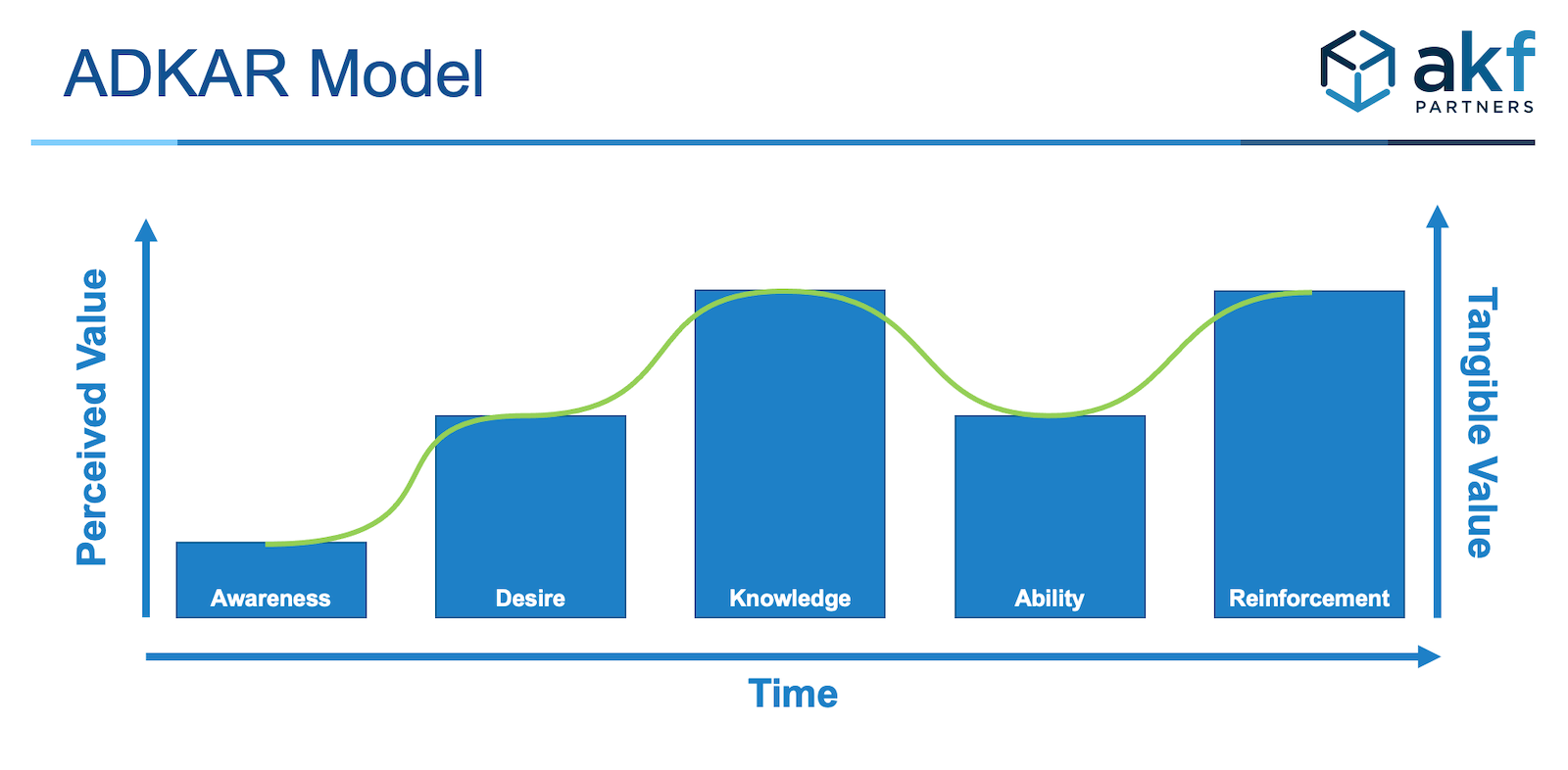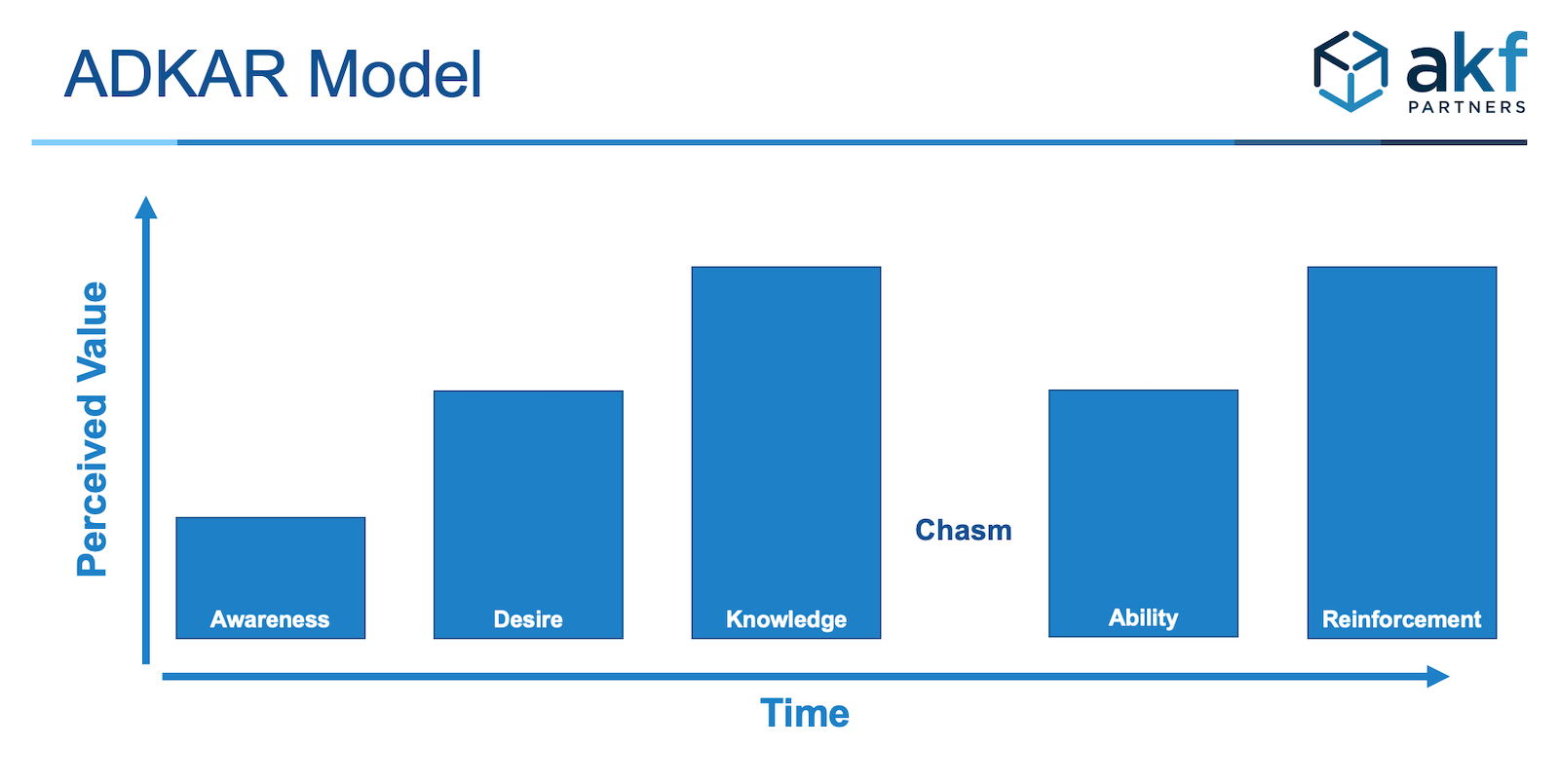“In the end, people are persuaded not by what we say, but by what they understand.” - John Maxwell
Organizational transformations are difficult. They are difficult because individuals and teams need to change behaviors. The behavioral changes are often significant. To persuade people to change behaviors, people need to understand why the status quo is not ideal.
Most people need to visualize how a future state is better than the current state for motivation. Many people also need to see how to transform or transition from the current state to the future state.
There are many change management frameworks to help individuals and groups change behaviors. One of the simplest ones we have found to help our clients is ADKAR.
ADKAR represents 5 stages of transformation. ADKAR stands for:
- Awareness - that better options are available
- Desire - to motivate someone that a future state is better than the current state
- Knowledge - understanding the path to the future state
- Ability - the learning curve of adopting new behaviors and stopping old behaviors
- Reinforcement - techniques such as recurring training to prevent old behaviors from re-emerging
ADKAR is often visualized as below:

One of the primary reasons people do not change behaviors is because they are stuck at one ADKAR stage. People often need to see the next stage before proceeding. Some risk averse people need to see all future stages before proceeding. When people are stuck, they fall back to old behaviors. This is sometimes visualized as a 'chasm' where people cannot see across one stage to the next stage.

This simple framework applies to individuals as well as organizations. For example, an individual may want to lose weight or improve at a sport. Both examples need the individual to change behaviors. Both examples need the individual to rewire their brain. Old behaviors are usually automatic or what Daniel Kahneman calls System 1. New behaviors are mentally difficult and need System 2 thinking. Transitioning through each ADKAR stage often requires System 2 thinking. It is almost always a deliberate practice to get through each stage.
Organizations are more difficult because a majority of individuals need to change behaviors. A majority of individuals need to go through each of the 5 ADKAR stages. Your goal as a leader is to get a majority of individuals through all 5 AKDAR stages as fast as possible.
We often help lead our clients through significant transformations such as:
- moving from on-premise software to the cloud
- splitting up large monolithic codebases and databases into smaller services
- getting leaders to make decisions supported by data versus relying on gut instincts
- implementing Agile development with CI-CD pipelines
- closing the loop between Product Managers and Engineering teams
- creating a platform from various codebases acquired via M&A
For organizational transformations such as these, we have found the following techniques effective:
- Awareness - scenario planning and benchmarking
- Desire - cost and risk analysis of the current state
- Knowledge - realistic model of the future state
- Ability - phased rollout of new tool and modified processes
- Reinforcement - training and operational reviews focused OKRs
I will describe each in more detail.
Awareness: Scenario Planning and Benchmarking
We first lead our clients through envisioning several good and bad scenarios. Business executives usually take part in these sessions. The 3 main categories we envision are financial:
- Revenue or growth opportunities. What customers are we unable to capture if we stick to the status quo? What markets are we unable to penetrate? If we could change the status quo, what is the top line revenue growth we can achieve?
- Wasted employee time. How much time are our employees wasting on non-value activities? What is the likelihood we will lose our top employees because we are too slow and bureaucratic? How many will follow those top employees?
- Cascading risks. What is the likelihood something bad happens and we cannot mitigate the impact? For example, our core platform is unavailable for hours or days. Or a competitor takes market share so fast that we are bleeding customers?
Often, the CEO or Board have already performed this scenario planning. If this has not occurred, we lead our clients through a 1 or 2 day scenario planning workshop.
Additionally, the leadership team needs a competitive benchmark as another input.
The majority of leaders are usually at the Awareness stage by the end of scenario planning. One or two are often well beyond this stage. Others may be skeptical due to similar exercises not leading to better outcomes.
Desire: Cost & Risk Analysis of Current State
The prior stage was a top-down exercise. This stage is a bottoms up approach. It requires more effort and time. But it can and should executed as fast as possible.
Big Picture artifacts are usually needed here. In the best scenarios, key leaders and employee help create these artifacts. Outside consultants can lead discussions to create these artifacts. However, outside consultants should not own them nor play them back to others. Employees with skin-in-the-game need to lead the communication and evolution of these Big Picture artifacts.
For example:
- Event Storms for splitting and/or merging monoliths. Business (product managers) and engineers must create these artifacts. Engineering only event storms are usually wrong and lead to failure.
- Process or Customer Journey maps. Business leaders should own and communicate business processes and relationship journeys. Existing process or journey maps can make event storming easier.
- Architectural diagrams. These are necessary to know where and how to split and merge monoliths at the codebase and database.
- DuPont diagrams. Dupont diagrams show which variables drive revenues, costs, and risks. The expose the formulas buried in spreadsheets.
The Big Picture artifacts of the current state are often used to create a financial model of the current state. A financial model for revenue could reflect a Customer Journey Map. It would show how improvements at each stage could amplify the company's revenue. Conversely, friction or problems could show cascading problems that decrease revenue.
A financial model makes it easier to forecast good, bad, or likely scenarios. Good scenarios could include features or services well received by the market. Bad scenarios would show declining revenue and customer abandonment. Likely scenarios include a mix of well received changes and misplaced bets.
Knowledge: Realistic Model of the Future State
A realistic model of the Future State is often a direct output of the prior stage. Engaged teams can identify short and long term improvements to the current state.
Sometimes, some team members cannot visualize the future state. These team members often need help picturing the future.
- For launching new features, mockups of new user experiences are very helpful here. This is common in Product Discovery. Feedback with real customers and prospects is a must.
- For splitting architectures into discrete services, Domain Driven Design is essential. Domain Driven Design (DDD) requires participation from Product Managers and Engineers. DDD is likely to fail with only one role.
- For purchases of large SaaS solutions (e.g. ERP, CRM), provide demonstrations of real user flows.
- For big investments, a timeline with frequent milestones is necessary. The milestones should have go/no-go decisions to avoid wasting time and money.
In the majority of scenarios, we recommend having prior expertise to guide the team. This could be a recent hire or an outside consultant.
Ability: Phased Rollout of New Capabilities
If you have made it to this stage, congratulations. We will warn you this next stage is one of the more difficult stages in transformations. This is where real behavioral changes occur.
In most companies, all 3 of these aspects change duration a transformation:
- Architecture - the prior architecture was designed for a different time and market. Engineers need to split and/or merge to the new architecture.
- Processes - prior processes have to change to reflect the needs of the market. This usually means faster or new processes.
- Organization - the existing organization needs to add new skills. Teams must form around the new architecture and processes.
Companies that only change 1 or 2 of these aspects usually fail in their transformations.
Companies that address all 3 will struggle at first before picking up momentum. Then they typically follow Tuckman's phases.
Reinforcement: Training and operational reviews focused OKRs
Operational reviews focused on the right metrics will track that the transformation is taking place. Left unguided, teams and individuals will fall back into old behaviors. Our CEO Guide to Engineering metrics are common for an Engineering organization transformation.
4DX explains the psychology of team dynamics with proper Ops Reviews. Teams perform better if they are taking score. Teams want to win if they know there is an audience.
Targeted and recurring training helps avoid falling back into old behaviors. It increases the likelihood of value realization.
Moving teams through ADKAR
If you think you’re leading, but no one is following, then you are only taking a walk. - John Maxwell
Individuals are often at different ADKAR stages in a transformation. Your goal as a leader is to move the majority through each stage as fast as possible.
Often, experienced leaders and subject-matter-experts (SMEs) are ahead of others in the ADKAR journey. The picture below shows different people at different stages. Be aware which key stakeholders are stuck at a particular stage.

To move teams through stages, these techniques are helpful at each stage:
- In-person workshops: to shorten the cycle times to get everyone on the same page
- Top-down buy-in: to have executives remove barriers and provide resources
Trying to hold ad-hoc and remote meetings only delays the ADKAR stages and your Transformation.
If you need help with transforming your platform, processes, or organization, contact us or attend our CTO Accelerator class.